If Mohammed does not go to the nuclear power plant

Energy is the main resource of humanity. More precisely, electricity. It came into use by historical standards quite recently, but has already become a source of life for us. Too much depends on it: industry, food production, water supply, transport management systems, urban lighting, a myriad of devices and devices, from elevators and air cleaning systems and building ventilation to your laptop and mobile phone. If electricity runs out in the outlet tomorrow, chaos and collapse will immediately begin. Even in rural areas, the disappearance of electricity will be, though not fatal, but a very unpleasant event. And for medium and large cities, this is a nightmare scenario, comparable to carpet bombing. Electricity is life.
We have repeatedly mentioned that many impressive developments, technologies and objects were created in our country in order to connect information, transport or resource distant territories and settlements. Electricity has not been forgotten either. More precisely, its sources. More precisely, experimental mobile NPPs existed in the USSR. Purkua, in fact, would not pas?
TPP-3
After the war, the USSR desperately needed various scarce metals, oil and gas. The atomic, rocket and space programs that required new technologies and industries were created at a rapid pace. So, it was required to find and develop new fields. All the same: beyond the Urals, in Siberia, beyond the Arctic Circle, in the Far East. These are giant territories stretching for thousands of kilometers. The nature here is harsh: the construction of roads requires tremendous efforts and costs, including maintaining it in working condition.
But somehow you have to live. And not just to live, but also to explore deserted territories, where there is no infrastructure. But for the life support of geologists and builders, the creation of industrial and mining facilities requires a lot of supplies and materials, and most importantly - energy. Therefore, in 1957, work began on the development of a mobile nuclear power plant. Pay attention to the courage of the idea: only 8 years ago the first Soviet atomic bomb was tested, and now it was necessary to create a compact and mobile nuclear power plant. Although it must be admitted that a mobile NPP would be primarily interesting to the military as a power source for radar and other secret facilities built in bear angles throughout the country.
The project was based on an atomic reactor developed at Laboratory “B” - this is how until 1960 the Physics and Energy Institute in Obninsk was called. It was a double-circuit heterogeneous water-to-water reactor containing 74 assemblies based on highly enriched uranium. Its capacity reached 8.8 MW. And the power of energy received from electric generators reached 1.5 MW. The reactor - without taking into account the rest of the strapping and aggregates - was a cylinder 600 mm high and 650 mm in diameter.
But no matter how compact the reactor was, the entire nuclear power plant as a whole represented impressive volumes and weights of the aggregate system. It was impossible to put all this on a single chassis either in size or in mass. More precisely, it would be possible, but the resulting monster could crawl only on a steppe as level as a table. Therefore, the components of the NPP were distributed over several self-propelled units. They took as a basis the chassis of a heavy T-10 tank:
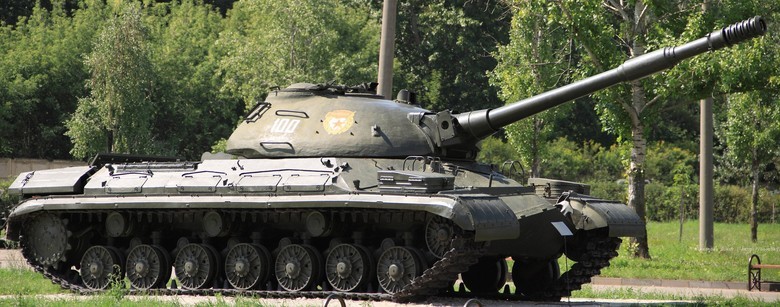
The chassis has undergone a serious alteration: it has been extended to 10 rollers on board instead of 7, and specially designed frames are installed on top, providing the spatial rigidity of self-propelled units. To reduce ground pressure, wider tracks were developed. Also designed protective anti-radiation screens.
In 1961, TES-3 was born - “transportable nuclear power plant”. The nuclear power plant consisted of four separate self-propelled guns, similar to a mixture of railway cars with huts:
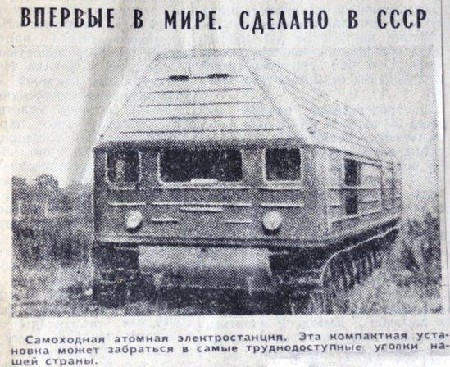


The total mass of equipment immersed in self-propelled guns was 210 tons, of which 28.5 tons accounted for “biological protection” - means of protection against radiation. And all together, self-propelled guns 310 tons of live weight. The autonomy of the “hike” of nuclear power plants reached 250 days. Each self-propelled gun was set in motion by the most powerful at that time in the USSR B12-6 tank diesel engine with 750 hp.
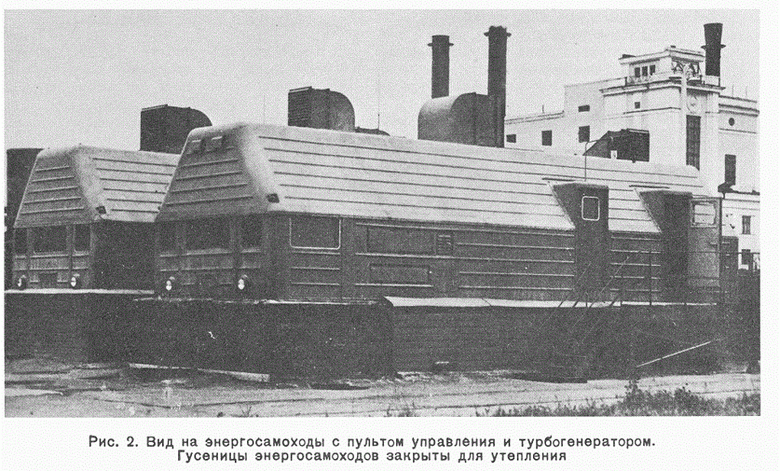
The composition of the main equipment:
- The first self-propelled gun: a reactor with an air radiator. Circulating water was used as a cooler, and the radiator was used for additional cooling of the reactor.
- The second self-propelled gun: steam generators, volume compensator, circulation pumps of the primary circuit.
- Third self-propelled gun: a turbogenerator with additional equipment. It was here that electricity was produced.
The fourth self-propelled gun: control point, backup diesel generator and batteries.

TPP-3 had to get under its own power to the place where electricity was required, after which the self-propelled guns lined up in the right order and connected with pipelines and cables. Then it was necessary to fill the lead tank with water, inside which the reactor itself was located (left lower self-propelled gun in the previous photo). Water acted as additional radiation protection. In addition, around the self-propelled guns with the reactor and steam generators, it was necessary to erect a box of concrete or earth (it was probably easier to dig shelters for the dumps along the perimeter for them in the ground). This was also dictated by the protection of personnel from radiation emitted by the reactor itself and the water circulating between self-propelled guns. After all the preparations could cut the switch.
Tests of TPP-3 continued until 1965, when the project was suspended, and in 1969 it was completely closed. Obviously, the use of “idle” nuclear reactors was considered too risky from a safety point of view.
Pamir-630D
But TPP-3 was not the only experiment of its kind. In 1963, work began on the development of a new mobile NPP. Development lasted a long time, in the amount of about 22 years. Only in 1985 was a working model finally built.
This time it was decided to abandon the water-cooled reactor. Its work required such an amount of water that it was simply impossible to provide in some regions where mobile NPPs are needed - for example, in the tundra or arid steppes. Therefore, a compact single-circuit reactor was mounted on the Pamir-630D, in which both the coolant and the working medium were nitrogen tetraoxide. This compound has a high thermal conductivity and heat capacity. But nitrogen tetraoxide is dangerous because of its chemical reaction with the formation of nitric acid. This fact significantly increased the danger of operating a nuclear power plant: if the personnel made a mistake, and water would be in the loop (for example, condensate), then the resulting acid could destroy the circuit elements or even the reactor itself.
The NPP complex consisted of four cars: two wheeled semi-trailers, towed by powerful MAZ-7960 truck tractors, which were processing MAZ-537, and two auxiliary vehicles based on KRAZ.
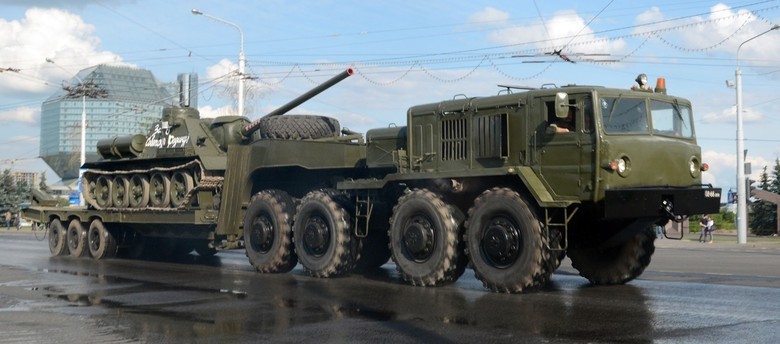
MAZ-357

Part of the equipment:
- The first machine (semitrailer): a reactor, a steam generator with a heat exchanger, an emergency cooling system, two autonomous diesel generators. At the stern of the semi-trailer there was a huge cooling system fan.
- Second car (semi-trailer): a turbogenerator (it generated electricity)
- Third car: NPP control system.
- The fourth car: backup diesel generators.
The reactor power is 10 MW, the turbogenerator power is 630 kW.
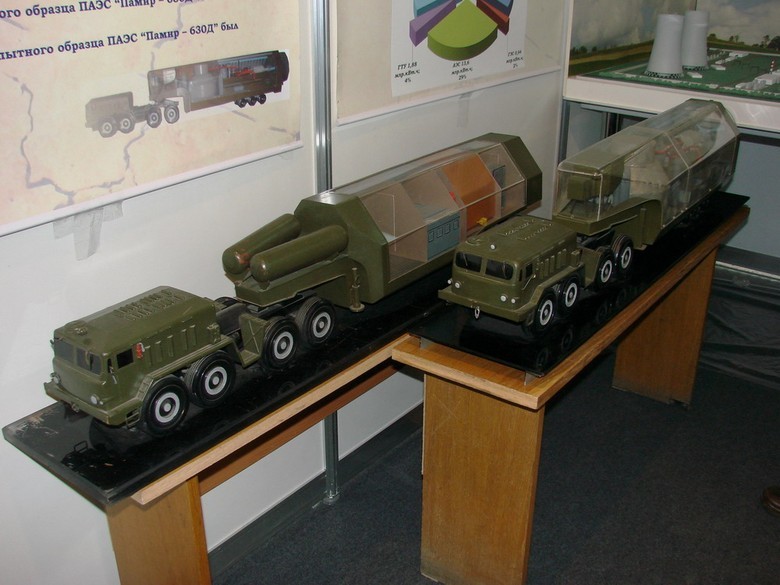
When a string of cars arrived at the parking lot, the reactor and turbo generator semitrailers were installed side by side, put them on jacks, removed and drove the wheels to a safe distance. The semi-trailers were connected with cables and pipelines, and not less than 150 m from them two other machines of the complex were installed. As you understand, all this was done to protect personnel from radiation. Not quite clear the moment with the wheels. The only thing that comes to mind: they had to be removed so that they themselves did not start fonit because of induced radioactivity and did not “infect” and then spread radioactive dust along the roads.
The tests of the Pamir-630D continued from November 1985 to August 1986, after which the project was closed. But on April 26, 1986, the fourth reactor of the Chernobyl nuclear power plant exploded, and this tragedy affected many projects in the nuclear power industry and the military industrial complex. The Pamir-630D began to actively criticize (and not without reason) as a technically dangerous construction, and finally in 1988 the project was closed. Information about the fate of machines is contradictory.
')
Source: https://habr.com/ru/post/370363/
All Articles